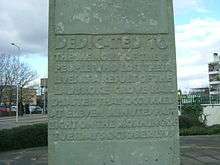Confidential Incident Reporting & Analysis System
 Ladbroke Grove rail crash memorial commemorating the 31 people who died near this spot in October 1999 | |
| Abbreviation | CIRAS |
|---|---|
| Formation | 1996 |
| Founder | ScotRail |
| Type | Confidential safety reporting service |
| Purpose | Provides a reporting process for rail workers to report incidents or concerns about facilities, equipment, conditions, or procedures |
Region | United Kingdom |
Official language | English |
The Confidential Incident Reporting & Analysis System (CIRAS) is a confidential safety reporting service for all workers in the United Kingdom rail industry. It operates under the oversight of the independent CIRAS Committee which is a unit of the Rail Safety and Standards Board (RSSB). Committee membership includes members from multiple interested parties: the British rail industry sectors (freight, infrastructure, Network Rail, passenger services, and LUL), the RSSB, the British rail unions, and individuals with special expertise from industry and academia. The service is funded by the rail industry, contractors, and all rail companies.[1][2]
History
CIRAS was originally created in 1996 by a team from Strathclyde University. Other rail lines expressed interest in the project and several rail lines in Scotland voluntarily joined the system. After the Ladbroke Grove rail crash in 1999, John Prescott mandated that all mainline rail in the UK come under CIRAS effective in 2000.[2] From 2001 until 2009, the CIRAS Charitable Trust provided funding for operations.[3] It now provides services to all rail workers and operating sectors throughout England, Scotland and Wales.[1][4]
Operation
CIRAS provides a reporting process for rail workers to report incidents or concerns about facilities, equipment, conditions, or procedures. CIRAS provides no-charge contact solution for rail industry employees to report concerns by telephone call, texting, postal notification, or Internet web submission. A CIRAS investigator collects further information for each report and works to see that it is as anonymous as possible.[5] These reports are sent to the responsible rail company for review, action, and response. Reports are categorized by operational function, location, and theme or topic.[2][5] Analyzed reports are published by CIRAS in its Sector Reports. CIRAS is responsible for notifying the original reporter of the resolution of the problem. Selected reports are also published in the bi-monthly CIRAS Newsletter.[1]
Significance
CIRAS is recognized as creating one of the safety industries taxonomies to classify human error and accidents.[6][7] It is an example of a reporting system which collects reports, including "near-misses", as a means of prevention instead of reporting only adverse outcomes.[8][9]
See also
- Railways Act
- Railways and Transport Safety Act 2003
- Department for Transport
- Rail Safety and Standards Board
- Rail Accident Investigation Branch
- Aviation Safety Reporting System (ASRS)
Sources
- Ladbroke Grove rail crash Report Part I
- RSSB - CIRAS Information
References
- 1 2 3 "CIRAS - the rail industry's confidential reporting system". Retrieved 2013-03-14.
- 1 2 3 Improving Safety-related Rules Compliance in the Public Transportation Industry, p. PA105, at Google Books ISBN 030921355X
- ↑ "The Ciras Charitable Trust". Retrieved 2013-03-14.
- ↑ 38 Rail Human Factors: Supporting the Integrated Railway, p. Chapter 38, at Google Books ISBN 0754643824
- 1 2 "CIRAS - the rail industry's confidential reporting system". Retrieved 2013-03-14.
- ↑ Wallace,B, and Alastair Ross. Beyond Human Error: Taxonomies and Safety Science; (CRC Press 2006).
- ↑ "Working to rule, or working safely? Part 1: A state of the art review". Safety Science. 55: 207–221. doi:10.1016/j.ssci.2012.05.011.
- ↑ "A Review of Medical Error Reporting System Design Considerations and a Proposed Cross-Level Systems Research Framework". Retrieved 2013-03-14.
- ↑ 39 Rail Human Factors: Supporting the Integrated Railway, p. Chapter 39, at Google Books ISBN 0754643824
External links
| Wikimedia Commons has media related to Rail transport accidents in the United Kingdom. |
- Official website
- "Impact of CIRAS". CIRAS Steering Committee. 28 March 2003. Retrieved 2013-03-14.
- CHIRP
- CHIRP for Aviation – Confidential Human Factors Incident Reporting Programme
- CHIRP for Maritime – Confidential Hazardous Incident Reporting Programme